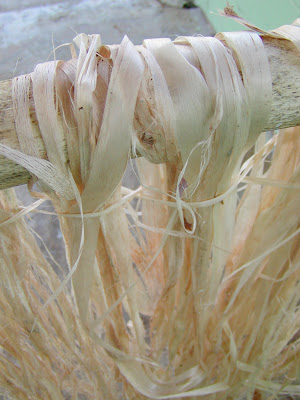
Pictured here are the beautiful golden pink colors of the inner bark of Hau, Hibiscus tiliaceus. One of the canoe plants of ancient Hawaii.
"Seeds and cuttings of hau were brought by early Polynesian voyagers to Hawai`i Nei, and planted by the settlers...and is held in high regard for its usefulness to the traditional life of oceanic people.
Hau grows well near the ocean, streams, and in moist sloping areas up to the 2000 foot elevation. This shrub spreads to form a creeping jungle of interwoven, curved and twisted springy arching branches.
Hau cordage, called `ili hau, provided tying material used daily. The cordage is made by cutting off stems and younger smooth branches, making a slit lengthwise and removing the bark with the hands. The bark strips are then soaked. When the outer bark is slipped off, remaining are cream-colored smooth fibers for braiding and twisting into cordage. Hau cordage provided ropes for hauling and many other needs. Hau is a true hibiscus. The bright yellow flowers have reddish centers and as the day goes by, the flower changes color to orange and then to reddish-brown, before it falls off the plant, usually by the next morning."
http://www.canoeplants.com/hau.html
A dye color can be made by collecting and cooking the flowers when they are yellow. It yields a most surprizing robins eggshell, baby blue color. I add this dye color to my paper pulp vat when I am lifting sheets of handmade paper. The papers have a beautiful soft blue color.
The photo above show strands of Hau that I harvested, stripped, soaked and set out to dry in preparation to make cordage. I use the hand twisted or braided cordage for bookbinding and as embellishment for my sculptures.

No comments:
Post a Comment